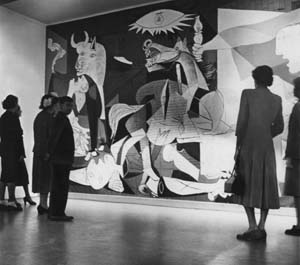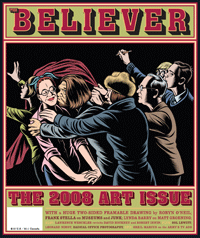Follow Scott
Recent Tweets
- Waiting for Twitter... Once Twitter is ready they will display my Tweets again.
Latest Photos
Search
Tags
anniversary Balticon birthdays Bryan Voltaggio Capclave comics Cons context-free comic book panel conventions DC Comics dreams Eating the Fantastic food garden horror Irene Vartanoff Len Wein Man v. Food Marie Severin Marvel Comics My Father my writing Nebula Awards Next restaurant obituaries old magazines Paris Review Readercon rejection slips San Diego Comic-Con Scarecrow science fiction Science Fiction Age Sharon Moody Stan Lee Stoker Awards StokerCon Superman ukulele Video Why Not Say What Happened Worldcon World Fantasy Convention World Horror Convention zombies
©2025 Scott Edelman
I believe in Art
Posted by: Scott
Tags:
Posted date:
November 20, 2008 |
No comment
The November/December 2008 issue of The Believer contains a fascinating article by art critic and historian Lawrence Weschler about the rivalry between artists Robert Irwin and David Hockney.
In an essay titled “The Paralyzed Cyclops: Mediating a Vivid, Decades-Long Argument Between Two Giants of Contemporary Art,” Weschler details the differing points of view held by these two artists, and how they’ve debated them without actually ever meeting:
Indeed, for some twenty-five years now, whenever I have written about one or the other of these two giants of contemporary art (arguably the two most significant artists to come out of the late-twentieth-century California art milieu), the other one has called effectively to tell me, “Wrong, wrong, wrong.” The two have never met or conversed in person (straddling that Southern California scene like Schoenberg and Stravinsky before them, each seemingly oblivious to the other’s existence though in fact deeply seized by the work); instead they have been carrying on this quite vivid argument for over two decades, through me, as it were.
An intriguing triangle, but what I found most interesting about the article was the following passage, which goes into the impossibility of truly reproducing art, while also explaining why I’m very familiar with Hockney’s work but know next to nothing about Irwin:
“I mean,” Hockney continued, “I’ve observed his progress, though at times that was by no means easy, and for the longest time I felt that his position on the photographing of his work”—a flat prohibition, as it happens (which is one of the principal reasons he was so much less well known among the public at large)—”was pretty preposterous, and somewhat fetishistic.” Irwin for his part accounted for that absolutist injunction by arguing that a photograph could capture everything that the work was not about (which is to say its image) and nothing that it was about (which is to say its presence), so why bother?
Hockney paused and took a drag on a cigarette before going on to confound me entirely: “The thing is,” he now said, “with time I’ve come to see that Irwin was right about that ban on photographing his work; I wish I’d imposed a similar ban regarding my own from the outset.” (This from an artist whose work was more photographed and more ubiquitously visible in the world than that of just about anybody else, with the possible exception of Andy Warhol!) “I mean, no one can come upon one of my paintings in a museum, say, and simply see it; instead they see the poster in their college dorm or the dentist’s office or the jacket on the book they are reading, all sorts of second-rate mediations getting in the way of experiencing the work as if from scratch.”
On first reading, I thought—makes sense to me. A reproduction of a work of art is no longer that work of art; it is something else entirely; it is its own art that is something separate, a changed and diminished object. Seeing a postcard of Picasso’s “Guernica,” for example, gives you no idea of what’s it’s like to walk into a gallery and have “Guernica” loom over you. Subtract the size, the texture, the smell of the paint, and so on, and have you really experienced the painting at all? An argument could be made that any copy is an insult to the intent of the original. I wonder what would it have been like to have seen “Guernica” that way for the first time, rather than having the initial viewing dulled by myriad misrepresentations of it. Until you’ve seen “Guernica” in person, you haven’t really seen it.
But as I thought about it further, I realized that this theory propounded by Irwin and embraced by Hockney has a major flaw, and that is—it is elitist to the core. It would result in the undemocratizing of art. It says that unless you can afford to travel to the location where the original work is being displayed, you don’t get to know it at all.

To continue with my “Guernica” example, prior to 1981, if you wanted to see the Picasso original, you would have had to travel to Manhattan to see it on display at the Museum of Modern Art, which worked out fine for me, as I grew up in Brooklyn and was able to commune with it many times. But those not lucky enough to have been born nearby might not have been able to afford to make that trip.
And since 1981, communing with “Guernica” has been even more difficult, for it meant a journey to Madrid for a visit to either the Museo del Prado or the Museo Nacional Centro de Arte Reina Sofía, out of range for any but the most well-off of us.
Sticking to this philosophy would mean that only the privileged few could ever experience it, or any other work of art. It is announcing to the world, my art is only for the rich. And that is wrong, for even a diminished “Guernica” is worth seeing, and is certainly better than no “Guernica.”
Neither Irwin nor Hockney has addressed that facet of the issue. (Well, perhaps they have, but if so, it isn’t referenced in this essay.) Perhaps even if my problem with it were brought to their attentions, they would still discount it, preferring that people not experience their art at all rather than see it in degraded form. Whether or not they’ve thought it out that far and realized the subtext of what they’re saying, that art should only be for the upper-classes, for the elite, I’ll continue to disagree.
You can have my posters, art books, and postcards when you take them from my cold, dead hands.


